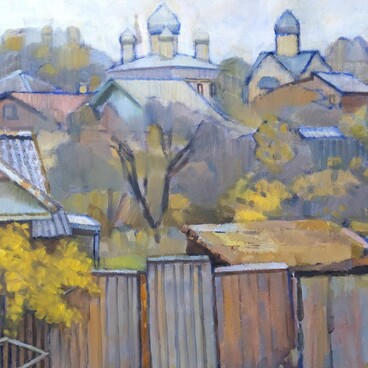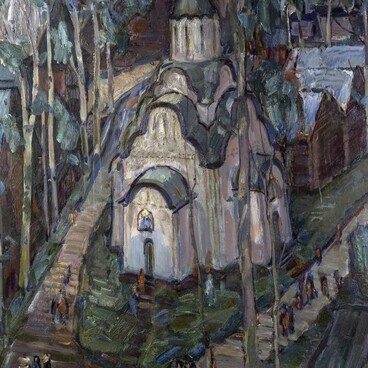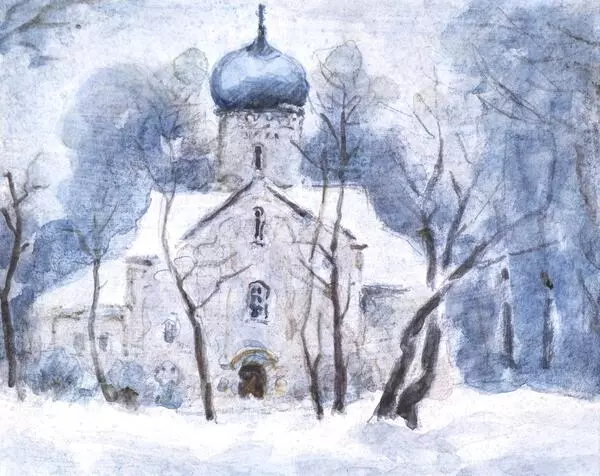An ancient Novgorod legend about the miraculous healing of the blessed Prince Mstislav Vladimirovich in 1113 is connected with the construction of the Church of St. Nicholas on Lipno Island.
Having fallen seriously ill, the prince called in his prayers on Nicholas the Wonderworker. The saint appeared to him and ordered to send messengers to Kyiv for a miraculous icon, describing it in detail.
Near the island of Lipno, the messengers were caught by a strong storm, after which they saw an image of Nicholas the Wonderworker on the water, painted on a round board, from the prince’s vision.
The icon brought healing to Mstislav Vladimirovich. In 1114, he ordered to lay a monastery on Lipno and build a wooden church in honor of Nicholas the Wonderworker.
The legend of the miraculous icon is not the only explanation for the church’s location — where the Msta River flows into Lake Ilmen. Not far from there ran the Volga trade route. In the charter of 1606, the road through Lipno is called “Bolshaya Moskovskaya” (“Big Moscow Road”), which was used both in winter and in summer.
In 1292–1294, during the rule of Archbishop Clement of Novgorod, a new church was constructed in white stone instead of the wooden one.
This is one of the first stone Novgorod cathedrals erected after the Mongol invasion. The architects who built it were guided by pre-Mongol Novgorod and Smolensk examples.
In 1293–1294, the church was decorated with frescoes.
The monastery was abolished in 1764 in connection with reforms of Catherine II (she nationalized all of the church lands); the Church of St. Nicholas continued to function for some time and was finally closed in 1917. Out of the entire complex of the monastery only the church has been preserved to this day.
Ancient Novgorod architectural monuments occupy a central place in the work of Semyon Ivanovich Pustovoytov. He grew up in an orphanage, and in 1939 he became a student at the Odessa Secondary Art School, but he was able to graduate only after the war, in 1951. Having started military service as a private, the artist was honorably discharged as a commander of a rifle squad. He had post-concussion syndrome, but managed to recover and lead an active life. Having fought in the Novgorod region, in peacetime, Semyon Ivanovich and his wife settled in Veliky Novgorod, and it was there that he established himself as a masterful watercolorist. He often collaborated with the museum-reserve, art workshops and the regional Center of Folk Art. In 1964, he became a member of the Artists’ Union.
Having fallen seriously ill, the prince called in his prayers on Nicholas the Wonderworker. The saint appeared to him and ordered to send messengers to Kyiv for a miraculous icon, describing it in detail.
Near the island of Lipno, the messengers were caught by a strong storm, after which they saw an image of Nicholas the Wonderworker on the water, painted on a round board, from the prince’s vision.
The icon brought healing to Mstislav Vladimirovich. In 1114, he ordered to lay a monastery on Lipno and build a wooden church in honor of Nicholas the Wonderworker.
The legend of the miraculous icon is not the only explanation for the church’s location — where the Msta River flows into Lake Ilmen. Not far from there ran the Volga trade route. In the charter of 1606, the road through Lipno is called “Bolshaya Moskovskaya” (“Big Moscow Road”), which was used both in winter and in summer.
In 1292–1294, during the rule of Archbishop Clement of Novgorod, a new church was constructed in white stone instead of the wooden one.
This is one of the first stone Novgorod cathedrals erected after the Mongol invasion. The architects who built it were guided by pre-Mongol Novgorod and Smolensk examples.
In 1293–1294, the church was decorated with frescoes.
The monastery was abolished in 1764 in connection with reforms of Catherine II (she nationalized all of the church lands); the Church of St. Nicholas continued to function for some time and was finally closed in 1917. Out of the entire complex of the monastery only the church has been preserved to this day.
Ancient Novgorod architectural monuments occupy a central place in the work of Semyon Ivanovich Pustovoytov. He grew up in an orphanage, and in 1939 he became a student at the Odessa Secondary Art School, but he was able to graduate only after the war, in 1951. Having started military service as a private, the artist was honorably discharged as a commander of a rifle squad. He had post-concussion syndrome, but managed to recover and lead an active life. Having fought in the Novgorod region, in peacetime, Semyon Ivanovich and his wife settled in Veliky Novgorod, and it was there that he established himself as a masterful watercolorist. He often collaborated with the museum-reserve, art workshops and the regional Center of Folk Art. In 1964, he became a member of the Artists’ Union.





